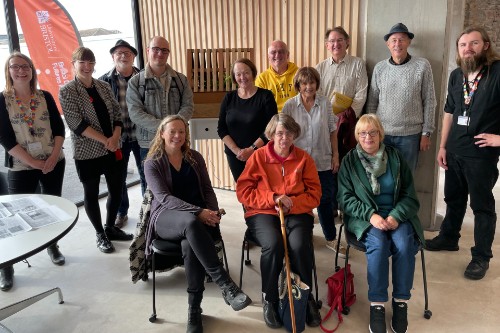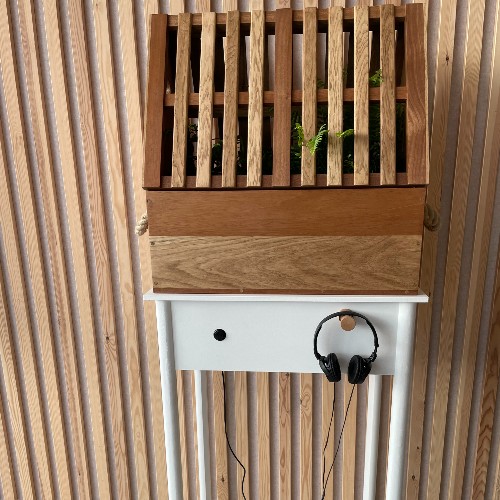
Barton Hill History Group with the Wardian Case. Bristol Digital Futures Institute

From left to right: Garry Atterton, Barton Hill History Group, Dr James Watts, University of Bristol, Ellie Shipman and Hayley Watts, Bristol Digital Futures Institute. Bristol Digital Futures Institute

Wardian Case at Bristol Digital Futures Institute. Bristol Digital Futures Institute
A new artwork embracing the industrial and societal history of the new home for the University of Bristol's first research hub in Temple Quarter Enterprise Campus was launched yesterday (Tuesday 11 October).
Commissioned by Bristol Digital Futures Institute, Injurious Effect, by local artist Ellie Shipman used accounts from residents in the Barton Hill History Group, interviews with historians Garry Atterton, Pete Insole and Dr James Watts, and local oral histories by researcher Lena Ferriday of the gas works in Avon Street to create an audio artwork and sculpture inspired by The Wardian Case.
The Wardian case, popular in Victorian homes to protect plants from perceived pollution from gas lights, explores the relationship between innovation, the fears and perceptions of technology and societal change, prompted by the history of the building that was the former headquarters of the Bristol Gas Company.
The Bristol Gas Company introduced gas and gas lighting to Bristol, transforming the way residents lived and worked in positive and negative ways.
Bristol Digital Futures Institute commissioned the installation for their newly renovated home to illustrate the history of innovation on the site from the last 200 years with the question, how can innovation protect what already exists, be used for good and mitigate harm?
Local memories, artifacts and photographs as well as a BDFI report, 'Avon Street Gasworks and Bristol Gas Industry' were put to use by Ellie to create the work.
Garry Atterton, founder of the Barton Hill History Group that host local memory cafes, said: "It has been a real pleasure working with local artist Ellie Shipman on this very exciting project about the Old Gas Works. The Barton Hill History Group has always tried to give working class people a voice and allow them the opportunity to tell their stories in their words. Hopefully the audio piece from Barton Hill people captures their memories and stories for present and future generations to learn from and enjoy."
Artist Ellie Shipman commented: "Fear of the new, of change and hidden or unseen implications have always gone hand in hand with socio-technical innovation. This artwork invites reflection on the past, present and future of innovation in Bristol through the symbol of The Wardian Case, which represents innovation and all the wondrous possibilities and harmful impacts it can bring."
Bristol Digital Futures Institute and Partnerships Manager, Hayley Shaw, said: "The development and production of the gas to fuel Bristol has many parallels with Bristol Digital Futures Institute which this art rightly addresses. It will help give us and visitors to our Temple Quarter Enterprise Campus home a chance to learn and reflect on its history while we take forward the principals of developing transformative socio-technical approaches to deliver a more inclusive, sustainable and prosperous future."
The history report, published in June, highlighted issues around working conditions, industrial action, the impact of war, the role of women in the workplace, the development of the night-time economy, crime, pollution, domestic life and the transformation of local businesses and industry including:
- How improved lighting meant that people could now work at night, paving the way for the night-time economy and changing concepts of time away from agricultural rhythms.
- The new gasworks, although dangerous, represented a steady and secure new source of employment.
- The Bristol Gas Company can be linked to every large industry in Bristol during the last 200 years, including Filton Aeroplane company, Wills Tobacco and Frys and Sons. The Bristol Old Vic was also an early customer.
- During the Second World War George Jones, gas attendant knocked two incendiary bombs off the top of the Folly Lane gas holder near Avon Street, receiving the George Medal for his efforts. There is a plaque on the wall on the corner of Folly Lane and Days Rd.
- Gas changed the lives of women in Bristol, not just through new employment opportunities but in the home being sold for cooking and washing as the 'fuel of the future'.
- Although gas was a significant source of pollution, with by-products entering the air and water-systems, the industry was effective at marketing itself as environmentally-friendly, winning awards from the Royal Sanitary Institute.
BDFI is a research institute, bringing together 28 industry, community and government partners with social science and computer science academics to transform the process of digital innovation. They occupy the former 'Retort House' and will be joined by the MyWorld creative hub in the adjoining 'Coal Shed' next year. New research facilities being created include a Neutral Lab and the world's first Reality Emulator.






